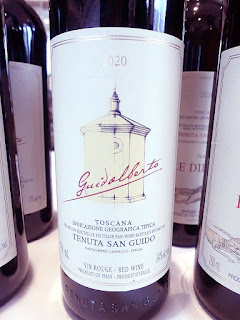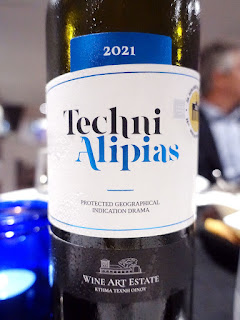red wine review is the latest vintage of a terrific red blend from Niagara that arrived at the LCBO last weekend as part of the LCBO VINTAGES Release.
It is produced by Creekside Estate Winery in small-town Jordan, Ontario, within the Niagara Peninsula. Creekside was founded in 1997 by Laura McCain and has a been a leader in producing distinctive, premium wines, and introducing grape varieties to Niagara that have expanded the horizons of the region. They are also known for their eclectic blends such as this wine - Laura's Blend - which has been made since the winery's founding in the late 90s.
Today, Creekside is owned by Diamond Estates Wines & Spirits Inc., but they are still led by the same group of passionate (and some say fanatical) group of industry veterans, chief among them winemaker Rob Power, who have decades of experience in their respective fields. The team of self-described cork dorks love what they do, and have fun doing it.
This lovely red wine is always a blend whose exact composition changes with each vintage, but always consists of red vinifera varieties Cabernet Sauvignon, Merlot, and Cabernet Franc, and often includes other varieties as well, with the end goal of creating the best wine possible. This particular edition was meticulously crafted with Cabernet Sauvignon, Merlot, Malbec, Cabernet Franc, Petit Verdot, and Syrah to create a wine with structure and ageing potential, but also with a core of good fruit that can also be enjoyed in its youth.
The 2018 growing season in Niagara was one of the most difficult vintages ever in terms of weather calamities with a hot summer season and very little rain, followed by rain, rain, and more rain mid-harvest. However, this didn't seem to impact grape quality too much as the resulting wines were all quite good in a moderate climate idiom. Let's see how this 2018 red wine from Niagara is tasting tonight...
Screw cap. This blend of 48% Cabernet Sauvignon, 38% Merlot, 6% Cabernet Franc, 4% Malbec, 3% Petit Verdot, and 2% Syrah has a fragrant, open, and medium-high intensity nose that delivers a fine, complex mix of red & black fruits, currant, cassis, oak spices, and grilled herbs with savoury earth undertones. It's medium to medium-full bodied on the dry palate with ripe black cherry, peppery spice, grilled herbs, currant, and cassis flavours all supported by fresh acidity and grainy textured, lightly grippy tannins. Flavours taper to savoury, chocolate, and oak spice notes on the finish, with very good length. A delicious, recommended buy! Score: 89 pts
Other lovely wines by Creekside are widely available at LCBO outlets across Ontario, and direct from the winery in Niagara.
It is produced by Creekside Estate Winery in small-town Jordan, Ontario, within the Niagara Peninsula. Creekside was founded in 1997 by Laura McCain and has a been a leader in producing distinctive, premium wines, and introducing grape varieties to Niagara that have expanded the horizons of the region. They are also known for their eclectic blends such as this wine - Laura's Blend - which has been made since the winery's founding in the late 90s.
Today, Creekside is owned by Diamond Estates Wines & Spirits Inc., but they are still led by the same group of passionate (and some say fanatical) group of industry veterans, chief among them winemaker Rob Power, who have decades of experience in their respective fields. The team of self-described cork dorks love what they do, and have fun doing it.
This lovely red wine is always a blend whose exact composition changes with each vintage, but always consists of red vinifera varieties Cabernet Sauvignon, Merlot, and Cabernet Franc, and often includes other varieties as well, with the end goal of creating the best wine possible. This particular edition was meticulously crafted with Cabernet Sauvignon, Merlot, Malbec, Cabernet Franc, Petit Verdot, and Syrah to create a wine with structure and ageing potential, but also with a core of good fruit that can also be enjoyed in its youth.
The 2018 growing season in Niagara was one of the most difficult vintages ever in terms of weather calamities with a hot summer season and very little rain, followed by rain, rain, and more rain mid-harvest. However, this didn't seem to impact grape quality too much as the resulting wines were all quite good in a moderate climate idiom. Let's see how this 2018 red wine from Niagara is tasting tonight...
Tasting Note:
CREEKSIDE LAURA'S RED 2018 - VQA Niagara Peninsula, Ontario, Canada (#117960) (XD) - $25.00Screw cap. This blend of 48% Cabernet Sauvignon, 38% Merlot, 6% Cabernet Franc, 4% Malbec, 3% Petit Verdot, and 2% Syrah has a fragrant, open, and medium-high intensity nose that delivers a fine, complex mix of red & black fruits, currant, cassis, oak spices, and grilled herbs with savoury earth undertones. It's medium to medium-full bodied on the dry palate with ripe black cherry, peppery spice, grilled herbs, currant, and cassis flavours all supported by fresh acidity and grainy textured, lightly grippy tannins. Flavours taper to savoury, chocolate, and oak spice notes on the finish, with very good length. A delicious, recommended buy! Score: 89 pts
Other lovely wines by Creekside are widely available at LCBO outlets across Ontario, and direct from the winery in Niagara.





































